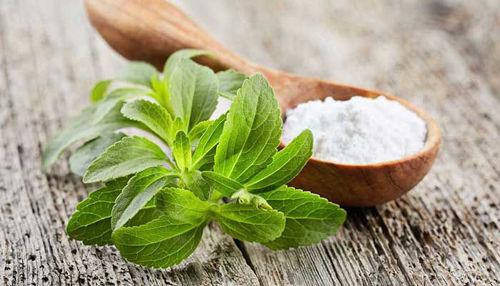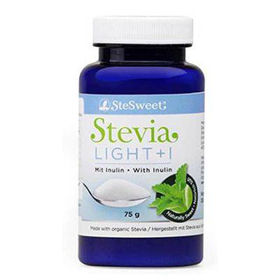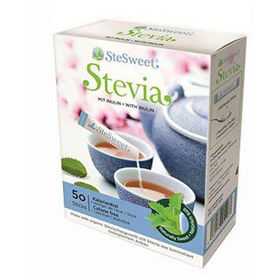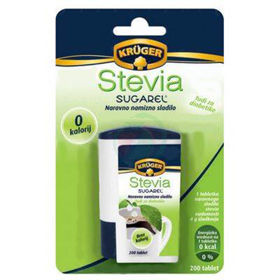Stevia is a sweet-tasting plant used to sweeten drinks and make tea since the 16th century. Stevia is approximately 100 to 300 times sweeter than table sugar but contains no carbohydrates, calories, or artificial ingredients.
Stevia: General | Composition | Benefits and Usage | Safety and Side Effects| Questions and Answers | Sources/references
Stevia is a natural sugar, unlike other sugar substitutes. It is made from leaves related to popular garden flowers such as asters and chrysanthemums. In South America and Asia, people have used stevia leaves for many years to sweeten drinks such as tea.
Stevia, also known as Stevia rebaudiana Bertoni, is a bushy shrub in the sunflower family. The plant originates from Paraguay and Brazil but is also cultivated in Japan and China.
Image: stevia sweetener is created from plant leaves related to popular garden flowers such as asters and chrysanthemums.

There are 150 species of stevia, all originating from North and South America.
Composition of stevia
Stevia contains eight glycosides. Glycosides contain a carbohydrate molecule converted into sugar (glycone) and a non-sugar component (aglycone or genin) by hydrolytic cleavage.
These glycosides include:
- stevioside
- rebaudiosides A, C, D, E and F
- steviolbioside
- glucoside A
Image: In South America and Asia, people have used stevia leaves for many years to sweeten drinks such as tea.

There is a big difference between the stevia you buy at the grocery store and the stevia you might grow at home. Stevia products found on store shelves do not contain whole stevia leaves. Instead, they are made from a highly refined stevia leaf extract called rebaudioside A (Reb-A).
Many stevia products have very little stevia in them. Reb-A is about 200 times sweeter than table sugar. Sweeteners made with Reb-A are considered "new sweeteners" because they are mixed with different sweeteners, such as erythritol (sugar alcohol) and dextrose (glucose).
Unlike artificial sweeteners made in a laboratory, stevia comes from plant leaves. The leaves are first collected, dried, and soaked in hot water. The liquid is then filtered and centrifuged to create an extract. The extract is mixed with several additives, such as dextrose or maltodextrin, to reduce the intense sweetness.
Video content: how to grow stevia at home?

You can also grow the stevia plant at home and use the leaves to sweeten food and drinks. Use fresh stevia leaves as a sweetener in drinks such as tea, lemonade, or sauces. A few fresh leaves of stevia and mint make a refreshing herbal tea if steeped in a cup of boiling water.
Benefits and uses of stevia
As a sweetener, stevia has become increasingly popular, especially among people with diabetes, as it has shown minimal or no effect on blood glucose levels, insulin levels, blood pressure, and body weight. This allows people with diabetes to eat more different foods.
Like other calorie-free sweeteners, stevia sweeteners are intensely sweet. However, Stevia sweeteners are 200-350 times sweeter than sugar, so only small amounts of Stevia sweeteners are needed to match the sweetness provided by sugar.
Food and beverage manufacturers can use Stevia sweeteners in beverages, canned fruit, condiments, dairy products, and other foods such as pastries, cereal, chocolate, and other confections. In addition, since sweeteners are stable at high temperatures, they can be used in bakery products.
Image: stevia, instead of regular sugar, may play a role in weight loss and management.

Replacing regular foods and drinks with tistimi, sweetened with stevia sweeteners, can play an essential role in weight loss and management. Since stevia does not contain calories, it can help you lose weight if you use it as a substitute for regular sugar.
Is stevia safe to use?
Stevia products made with Reb-A are safe for pregnant women or diabetics. In addition, these products rarely cause side effects, but more research is needed to provide conclusive evidence on weight management, diabetes, and other health problems.
Some stevia products contain additives that can cause side effects. For example, sugar alcohols can cause the following symptoms in some individuals:
- flattening
- nausea and vomiting
- abdominal pains and cramps
- other digestive problems
Whole leaf stevia is not approved commercially, but you can still grow it for home use. Despite the lack of research, many claim that whole-leaf stevia is a safe alternative to its highly refined counterpart or table sugar.
Video content: 10 best and ten worst sweeteners.

While adding a raw stevia leaf to a cup of tea occasionally probably won't do any harm, it shouldn't be used if you're pregnant. Until research determines whether whole-leaf stevia is safe for everyone, get your doctor's approval before using it regularly, especially if you have a severe medical condition such as diabetes, heart disease, or high blood pressure.
Questions and answers
Can stevia be grown at home?
You can grow the stevia plant at home and use the leaves to sweeten food and drinks. Use fresh stevia leaves as a sweetener in drinks such as tea, lemonade, or sauces. Fresh stevia and mint leaves make a refreshing herbal tea in a cup of boiling water[1].
Can consuming stevia cause side effects?
Stevia is considered safe, even for pregnant women or patients with diabetes. Stevia products rarely cause side effects, but some contain additives that can cause specific side effects. For example, sugar alcohols can cause the following symptoms in some individuals:
- flattening
- nausea and vomiting
- abdominal pains and cramps
- other digestive problems[2]
Image: stevia is considered safe, even for pregnant women or patients with diabetes.

Does stevia raise blood sugar?
As a sweetener, stevia is popular among people with diabetes, as it has shown minimal or no effect on blood glucose levels, insulin levels, blood pressure, and body weight[3].
>
Sources and references
1. 3 Highly Recommended (Non-Culinary) Herbs to Grow at Home to Improve Your Health & Wellness - https://www.gardens-with-purpose.com
2. Does stevia have any side effects? - https://www.medicalnewstoday.com
3. Effects of stevia on glycemic and lipid profile of type 2 diabetic patients - https://www.ncbi.nlm.nih.gov












 Facebook
Facebook
 Instagram
Instagram
 info@moja-lekarna.com
info@moja-lekarna.com

